A symmetrical triangle is a chart pattern used for technical analysis that forms when the price of an asset fluctuates within a narrow range, forming two converging trendlines. A symmetrical triangle pattern creates a triangle shape, with the upper trendline representing resistance and the lower trendline representing support.
A symmetrical triangle denotes a time of market consolidation during which buyers and sellers are in a state of equilibrium. The gap between the trendlines reduces with time as the price stays within the triangle, suggesting that a breakout will happen soon. The trend lines formed in the symmetrical triangle should be converging at a roughly equal slope. Rising wedges, falling wedges, ascending triangles, and descending triangles are all terms used to describe trend lines that are converging at differing slopes.
A symmetrical triangle is formed during an upward or downward trend that lasts for several weeks to several months. The two converging trend lines formed should hit at least two highs and two lows to confirm the pattern. The pattern is also confirmed when the price exits the triangle, which occurs with high trading volume.
The symmetrical triangle pattern has the biggest advantage of offering traders a distinct entry and exit point. Traders use this pattern to avoid initiating a trade too early and being caught up in a fake breakout by waiting for a breakout.
What exactly is a Symmetrical Triangle Pattern in Technical Analysis?
A symmetrical triangle is a chart pattern characterised by two converging trend lines attaching a series of sequential peaks and troughs. A symmetrical triangle pattern depicts a period of uncertainty in the market and is formed when the price of an item develops two convergent trend lines with a similar slope on a technical analysis chart.
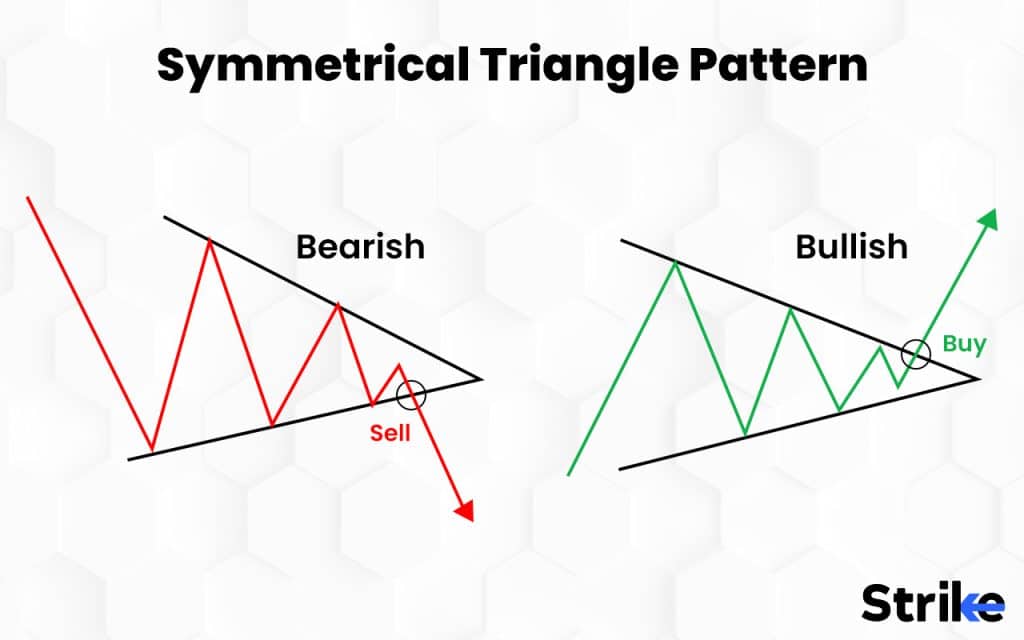
The price of the asset either rises or dips after the breakout depending on the slope of the converging lines. The price volatility in the symmetrical triangle pattern declines with time, and the distance between the two trend lines gets smaller as the pattern develops. This convergence of lines suggests that supply and demand dynamics are aligning more evenly, which will lead to a price breakout. The following image clearly depicts the price movement between the converging lines of a symmetrical triangle pattern in technical analysis.
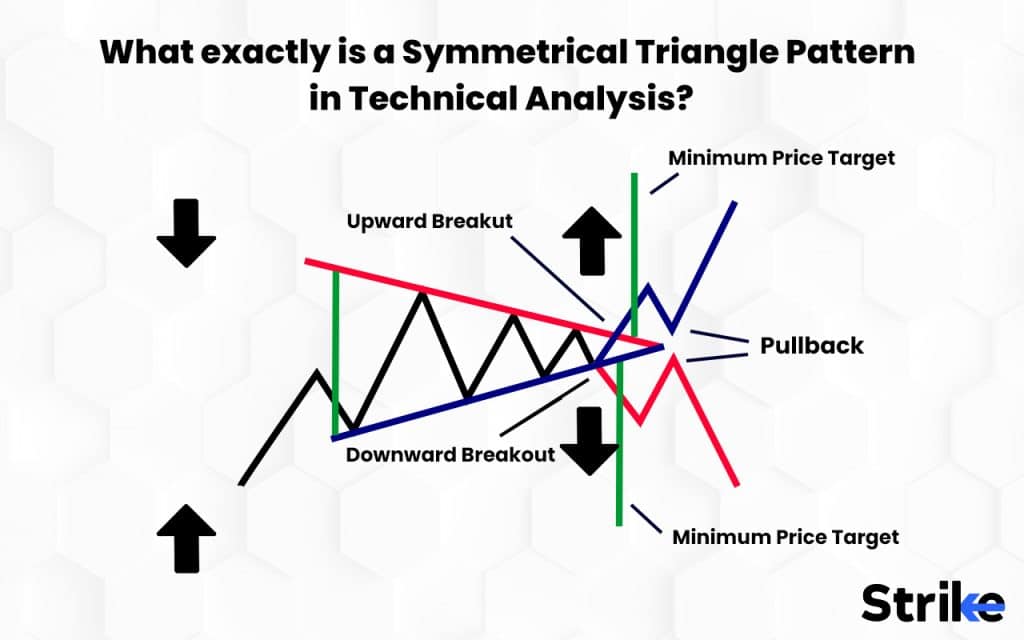
A symmetrical triangle pattern’s breakout happens in either direction until the breakout point of the pattern is regarded as neutral. Trading volume plays an important role in determining the efficiency of the pattern as traders seek confirmation of the breakout through a sizable price move in the breakout’s direction, accompanied by increased trading volume.
Symmetrical triangles are found in all time frames, and traders use them to spot potential trading opportunities for all different forms of assets like stocks, forex, cryptocurrencies, and commodities. Traders should understand and remember that not every symmetrical triangle pattern will lead to a major price movement .
How does a Symmetrical Triangle Pattern work?
The symmetrical triangle pattern works on the principle of price consolidation and market indecision. The symmetrical triangle pattern represents a temporary pause or rest in the ongoing trend at which the price of assets is balanced, due to indecision in the market.
A Symmetrical Triangle Pattern signifies decreasing volatility and a potential buildup of energy, as the price range contracts within the triangle. Traders closely observe this pattern as the converging lines suggest that a significant price movement or breakout is likely to occur. The breakout from the triangle indicates the resolution of the market indecision and often leads to a continuation of the previous trend. The market intention after the breakout point is decided by the traders with the help of inclination of trend lines.
There are three variations within the symmetrical triangle pattern that affect how traders interpret and trade it.
Normal Symmetrical Triangle: The most typical symmetrical triangle pattern is the normal symmetrical triangle, in which both trend lines slope at roughly the same degrees towards the triangle’s apex. Traders interpret this pattern as a sign of uncertainty in the market as the price moves towards a potential breakout point.
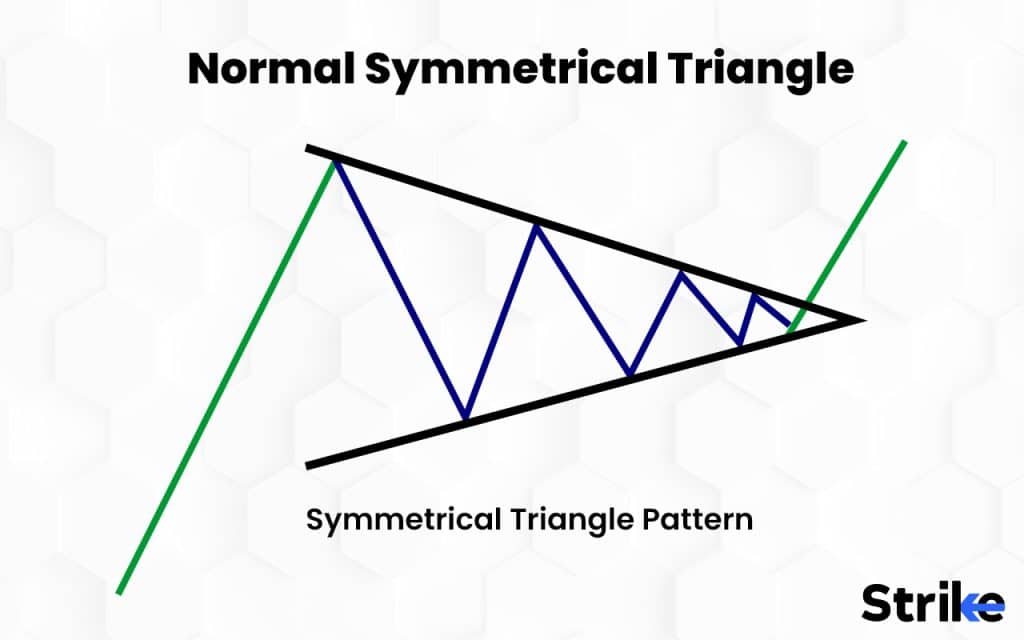
Flat Top Triangle: The lower trendline slopes downward while the higher trendline is comparatively flat in this variant. This is seen as a bearish indication since it shows that the asset is under pressure from bears who are driving the price of the assets lower.
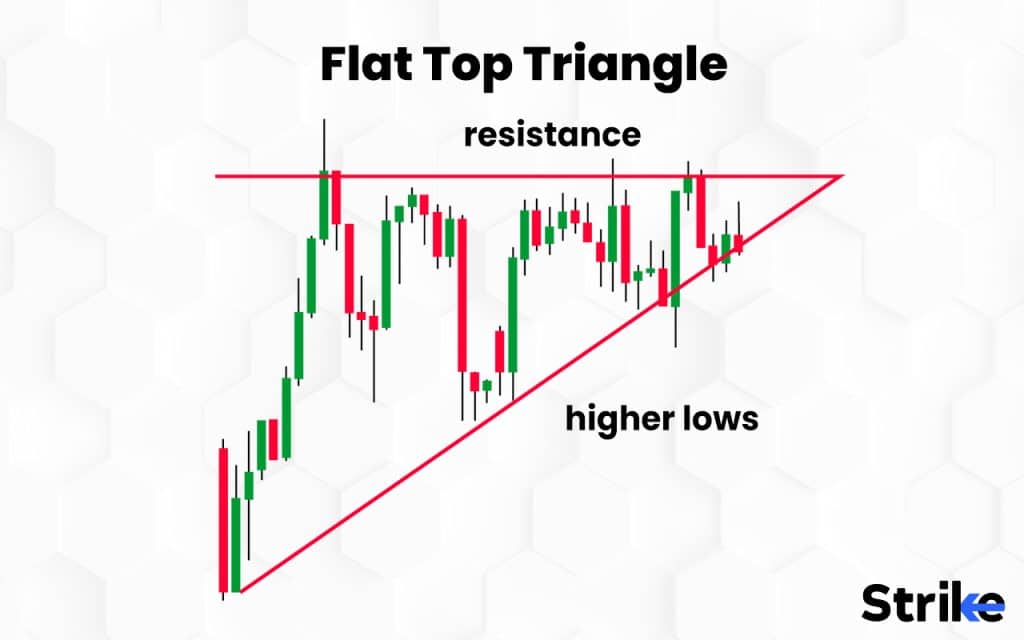
Flat Bottom Triangle: This pattern is completely opposite of the “Flat Top Triangle” pattern as it depicts a bullish trend. The lower trend line in this pattern is flat, while the upper trendline slopes upwards.
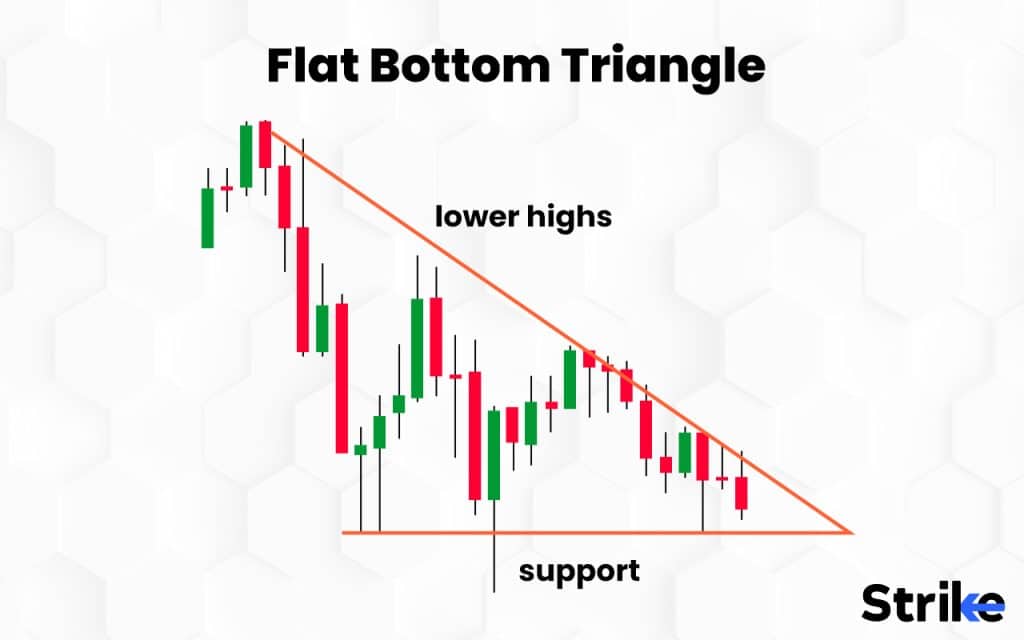
The distance between the two trendlines gets smaller in all forms of Symmetrical Triangles as the price goes closer to the triangle’s apex, suggesting that the forces of supply and demand are balancing out more evenly. This indicates a potential breakout, during which the asset’s price moves sharply either up or down.
Traders wait for a large price move in the breakout direction, accompanied by increasing trading volume, in order to trade a symmetrical triangle pattern. The moment at which the asset’s price crosses either the upper or lower trendline of the triangle formation is known as the breakout point. The two converging trend lines depict market sentiment and a potential breakout point.
What is the importance of Symmetrical Triangle Pattern in Technical Analysis?
The Symmetrical Triangle Pattern is an important chart pattern in technical analysis due to its potential for predicting future price movements, its indication of a period of consolidation or indecision in the market, and its applicability to various timeframes and financial instruments. The five main importance of using Symmetrical Triangle Pattern in Technical Analysis are listed below.
Value as a predictor. The pattern gives traders important information about the direction and probable size of future price moves. A substantial trend reversal or continuation is indicated by a breakout from the pattern. Traders anticipate significant trend reversals or continuations, by recognizing the pattern and its subsequent breakout, allowing them to make informed trading decisions.
Risk management. Traders set appropriate stop-loss levels to impose a cap on possible losses and manage risk by identifying important support and resistance levels within the pattern. This helps traders to manage risk and protect their capital in case the price moves against their anticipated direction.
Confirmation. The pattern is confirmed using other indicators like volume, momentum oscillators, or trend analysis. This reduces false breakouts and gives greater confidence in trading signals. Multiple tools confirming the pattern improves reliability.
Clarity. The symmetrical shape formed clearly represents the market struggle between bulls and bears. This visual representation helps traders comprehend the prevailing forces and dynamics. The clean lines allow for pattern recognition.
Entry/Exit Signals. The pattern typically narrows as the apex approaches, forecasting an imminent breakout. This alerts traders to potential trading opportunities around the corner. The narrowing range indicates building energy for a volatile breakout. Traders can prepare to react accordingly.
The symmetrical triangle pattern is a useful tool for traders and analysts looking to spot potential trend reversals or continuations and properly manage risk. Traders increase their chances of success by making better trading selections by comprehending the traits of the pattern and its implications for upcoming price movements.
What is the Importance of The Support and Resistance Lines in A Symmetrical Triangle Pattern?
The support and resistance lines in a symmetrical triangle pattern are crucial because they are used to predict potential breakout points and control risk.
The support line is the triangle’s lower limit, and it represents a point at which purchasing pressure has in the past stopped the price from sliding any lower. Traders try to enter long positions in the hope that buying pressure will once again drive the price higher when the price reaches the support line.
The resistance line serves as the triangle’s top border, denoting a point at which selling pressure has historically blocked price increases over that level. Traders could try to enter short bets in the hope that selling pressure will once again drive the price down when the price reaches the resistance line.
How to identify the Symmetrical Triangle Pattern in Price Chart?
The six main steps involved in identifying the Symmetrical triangle pattern in the price chart are listed below.
Find a trend. The first step is to find a trend, either bullish (upward) or bearish (downward), in the price chart. The trend should already be there before the pattern is formed.
Draw trend lines. Identify the trend and then draw two trend lines, one connecting the higher highs and the other the lower lows. The intersection of these trend lines should result in a triangle.
Watch for a string of higher lows and lower highs. This pattern indicates a period of consolidation where the price is making lower highs and higher lows, ultimately resulting in converging trendlines. This is seen as a sign of indecision in the market as bears and bulls are in equilibrium.
Find the apex. The apex is the intersection of the two trend lines. Price movement towards the apex suggests that a breakout is about to occur.
Find the support and resistance line. Look for a break above the upper trend line (resistance) or a break below the lower trend line (support) to help traders spot potential breakout locations.
Confirm the breakout. It is crucial to wait for confirmation of a breakout, prior to entering a trade. A candlestick pattern or high volume could provide confirmation.
Identifying a symmetrical triangle pattern in a price chart involves looking for a series of higher lows and lower highs, drawing converging trendlines, analysing the pattern, observing reducing trading volume, and waiting for a breakout confirmation. Traders potentially anticipate future price movements and make informed trading decisions, by using this pattern.
What are the key Characteristics of Symmetrical Triangle Pattern?
The six key Characteristics of the Symmetrical triangle pattern in the price chart are listed below.
Convergent Trend Lines. Two trend lines that are convergent—one connecting a series of higher lows and the other a series of lower highs—form the pattern. The triangle is created when the two trend lines converge.
Symmetrical Shape. Two trend lines should be substantially parallel to one another for the pattern to have a symmetrical shape.
Consolidation. The pattern is produced as the price moves back and forth between the two trend lines. It is possible that the price will move in either way due to the equal strength of the buyers and sellers.
Volume. The pattern’s tendency to form with reduced volume suggests that traders are holding off on entering positions until the pattern is broken.
Breakout. A breakout in one way or another resolves the pattern. This takes place either just before the pattern reaches the pinnacle or right when it does.
Price target. Traders forecast a price goal for the breakout using the triangle’s height. This is accomplished by measuring the separation between the triangle’s high and low points and projecting that measurement in the direction of the breakout.
Trading professionals recognize and possibly profit from the Symmetrical Triangle Pattern by comprehending these essential features.
How reliable is a Symmetrical Triangle Pattern?
The pattern is typically seen as a trustworthy indicator of a probable trend reversal or continuation, as it denotes a period of market consolidation before a breakout in one way or the other. The period, the state of the market, and the presence of other technical indicators are some of the variables that affect how reliable a symmetrical triangle pattern is as a trading indicator.
Traders should be aware that the pattern occasionally fail, particularly in cases of low volume or when the price breaks out in the opposite direction of expectations. It’s crucial to apply additional technical analysis tools, like candlestick patterns, volume analysis, and momentum indicators, to corroborate the signal.
Traders should also take this into account that shorter time frames are more volatile and prone to false breakouts. Longer timeframes, on the other hand, offer a signal that is more dependable but with fewer trading chances.
What is the Duration of The Symmetrical Triangle Pattern in Technical Analysis?
The duration of a symmetrical triangle pattern in technical analysis changes significantly, depending on the timeframe being examined and the state of the market. The pattern often lasts a few weeks to many months, but it is occasionally shorter or longer. The time it takes for the two converging trend lines to emerge and the price to stabilize inside the triangle determines how long the pattern will last. Market volatility, volume, and the potency of the trend that gave rise to the pattern can all have an impact on this.
How to Trade with a Symmetrical Triangle Pattern?
The six main steps to trade with a Symmetrical Triangle Pattern in the price chart are listed below.
- Recognise the pattern: Watch for a pattern of symmetrical triangles formed by convergent trend lines, with the price bouncing between the levels of support and resistance.
- Find Breakout: Watch for a breakout in either direction, once the pattern has been determined. A candle closing above or below the trend lines or a big rise in volume also indicate this.
- Validate the breakout: Use other technical analysis tools, such as momentum indicators for validating the breakout’s direction and for gauging the strength of the move.
- Enter the trade: Place a position in the breakout’s direction, once the breakout has been verified. Perform this by placing a stop order above or below the breakout point, to avoid further losses.
- Set A Target And A Stop Loss: Set a target price for profit-taking and a stop-loss level to cap potential losses if the transaction goes against the trader.
- Follow the market: Watch the price movement and alter positions as appropriate. Consider adjusting the stop-loss level to lock in profits if the price goes sharply in trader’s favour.
Always exercise caution when trading with a symmetrical triangle pattern because it is dangerous. Always manage risk appropriately and be ready to adapt your trading approach as per the market conditions shift.
What Are the Key Factors to Consider Before Trading a Symmetrical Triangle Pattern?
The first key consideration is the preceding trend. An ideal symmetrical triangle forms in the middle of a strong uptrend or downtrend. The pattern itself represents a consolidation phase within the bigger trend. Therefore, the preceding trend provides clues on the likely breakout direction. If a strong uptrend exists prior to the triangle, there is a higher probability of an upside breakout and vice versa.
The second factor is the timeframe. Symmetrical triangles are most significant on larger timeframes like the daily and weekly charts. Triangles on smaller timeframes like hourly or 15 mins are less reliable. The pattern needs time to develop and form the convergence. Trading triangles on larger timeframes improves the odds of success.
The third element is triangle proportions. An ideal symmetrical triangle has the two trendlines converging at roughly equal angles. The pattern should also extend for a period of time, typically lasting 3-6 weeks from start to apex. Triangles that are lopsided or form very rapidly are less reliable. Checking the symmetry and timeline makes sense.
The fourth aspect is triangle volume. As the pattern evolves, trading volume should diminish. This indicates decreased conviction among market participants as consolidation sets in. Spikes in volume as the triangle apex approaches often foreshadow an imminent breakout. Rising volume adds conviction.
The fifth factor is triangle slope. Uptrending symmetrical triangles have higher breakout odds as they demonstrate buying pressure. The opposite is true for downtrending triangles. Analyzing the overall price slope within the triangle provides additional clues.
The sixth key consideration is breakout volume. Heavy trading volume on the breakout bar validates the triangle breakout. Light breakout volume is a warning sign that the pattern failed. Using volume confirmation improves accuracy greatly.
The seventh element is breakout price. Traders should wait for a clear break of the upper or lower triangle trendline by 3-5% before trading the breakout. Premature entries right at the apex often fail. Allowing price confirmation ensures higher odds.
What is the best way to Trade Symmetrical Triangle Pattern?
The strategy to trade the symmetrical triangle pattern will rely on the trader’s personal preferences and risk tolerance, as well as market conditions and other technical aspects. There is no universally applicable solution to this topic.
The three main pieces of advice and practices to help traders when trading the symmetrical triangle pattern are listed below.
- Wait for a confirmed breakout: One of the most crucial things to remember while trading the Symmetrical Triangle pattern is to hold off on placing a trade until a confirmed breakout has occurred from the pattern. This entails waiting for a confirmation indication, such as a powerful candlestick pattern or a spike in trading volume, once the price has broken out of the triangle’s upper or lower trend lines.
- Think about using stop-loss orders: Stop-loss orders are a beneficial tool to assist control risk and help limit any losses when trading the Symmetrical Triangle pattern. Traders should think about placing a stop-loss order just below the breakout point of the pattern.
- Be aware of current market conditions and other outside factors: It’s critical to be aware of current market conditions and other outside factors that affect how well the Symmetrical Triangle pattern performs.
Traders will improve and gain experience by applying these above-mentioned tips and advice on a demo account or with small position sizes before risking significant capital.
What Indicator is best to Trade with Symmetrical Triangle Pattern?
The Symmetrical Triangle pattern is traded with a variety of indicators, and there is no one “best” indicator for doing so because every trader has their own tastes and methods.
Traders frequently combine the Symmetrical Triangle pattern with a number of other indicators, to help discover prospective trading opportunities and validate the strength of the trend. The Symmetrical Triangle is used with indicators like Moving Averages, Relative Strength Index (RSI), Moving Average Convergence Divergence (MACD), Bollinger Bands, etc.
Can RSI be used to trade together with the Symmetrical Triangle Pattern?
Yes, the Relative Strength Index (RSI) indicator is used in combination with the Symmetrical Triangle chart pattern for technical analysis.
The RSI is a momentum oscillator that gauges how quickly and dramatically prices move. It oscillates between zero and one hundred, with readings above seventy denoting overbought conditions and below thirty denoting oversold conditions.
The Symmetrical Triangle pattern in combination with RSI is used by traders to determine the strength of the trend. This combination supports a potential long position and confirms a bullish trend, If the price breaks out of the upper trend line of the triangle, and the RSI is above 50 and rising.
This confirms a bearish trend and supports a potential short position when the price breaks out of the lower trend line of the triangle, in case the RSI value is below 50 and falling.
Can MACD be used to trade together with the Symmetrical Triangle Pattern?
Yes, the Symmetrical Triangle pattern is utilised in conjunction with the Moving Average Convergence Divergence (MACD) indicator to provide additional confirmation of prospective trading opportunities.
The MACD indicator tracks the relationship between two moving averages of a security’s price and is a trend-following momentum indicator. The 26-period exponential moving average (EMA) is subtracted from the 12-period EMA to generate the MACD. The MACD is then placed on top of a 9-period EMA to serve as a signal line.
The MACD is used by traders to validate the trend’s strength and direction, as indicated by the symmetrical triangle formation. The MACD supports a potential long position and confirms a bullish trend, when the price breaks out of the upper trend line of the triangle, and the MACD is going higher and above the signal line.
This supports a potential short position when the price breaks out of the triangle’s bottom trend line and confirms a bearish trend, If the MACD is moving lower and below the signal line.
What is an example of a Symmetrical Triangle Pattern in Trading?
The chart below illustrates an example of a symmetrical triangle pattern that has emerged in the long-term time frame of Northwest Bancshares (NWBI).
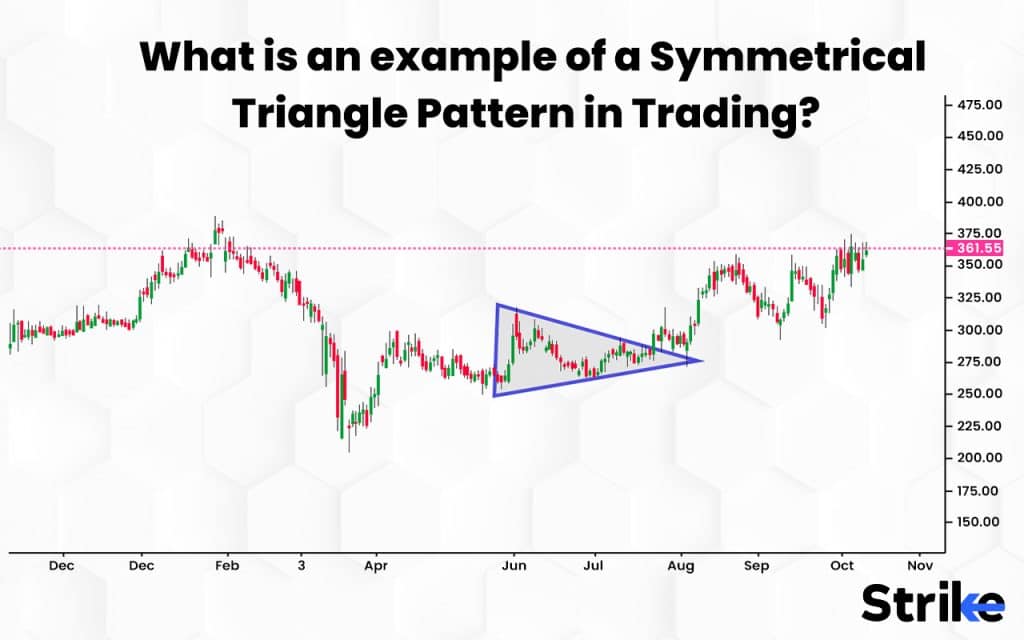
We observe that a symmetrical triangle pattern has developed, between the two trend lines that join the run of lower highs and higher lows. This denotes a period of market stabilisation and uncertainty, with buyers and sellers vying for dominance.
We also observe a decline in the volume of assets being traded as the price draws closer to the triangle’s peak, which directly indicates that traders are growing more reluctant and unsure about the direction of the next move.
The market moves for a breakout, after the formation of a Symmetrical Triangle Pattern. The breakout happens in either direction, depending on the slopes of the trend lines and the volume of trades.
What are the Advantages of Symmetrical Triangle Pattern in Technical Analysis?
The Symmetrical Triangle pattern is a valuable tool in technical analysis that gives traders precise signals to enter and exit positions as well as hints about prospective price targets. The symmetrical triangle pattern in technical analysis offers following five advantages:
- Clear Entry and Exit Signals: Traders are able to identify points to enter and exit trades using the Symmetrical Triangle pattern. Traders take a position when the price exits the triangle formation. Traders then get out of the position when the price reaches a predetermined target or stop loss level.
- Gives indications of Prospective Price Objectives: The symmetrical triangle pattern after the breakout gives indications of prospective price objectives. A potential price target is calculated by traders by measuring the separation between the triangle’s two trend lines and extrapolating that distance from the breakout point.
- Used for Short-Term and Long-Term Trading: The Symmetrical Triangle pattern is used for both short-term and long-term trading strategies. This makes it a versatile tool for traders of all levels.
- Used In All Markets: The Symmetrical Triangle pattern is applicable to all markets, including equities, commodities, foreign exchange, and cryptocurrency. The Symmetrical Triangle pattern’s major advantages including identification of price consolidation, trend continuation or reversal, volatility contraction, and widespread recognition, are applicable across different markets.
- Helps in Trend Identification: The Symmetrical Triangle pattern aids the traders for identifying market trends, including the trend’s intensity and direction. Trading decisions are made more intelligently and risk is managed more skillfully as a result.
Traders gain a deeper understanding of market dynamics and improve their decision-making process, by incorporating the symmetrical triangle pattern into their trading strategies.
What are the Disadvantages of Symmetrical Triangle Pattern in Technical Analysis?
The traders make more informed decisions in the market by understanding the drawbacks associated with the Symmetrical Triangle pattern in technical analysis. Traders should be aware of the following four potential disadvantages.
- False Breakouts: One of the biggest disadvantages of the Symmetrical Triangle pattern is that it produces false breakouts. The price breaks out of the triangle pattern, only to re-enter it shortly thereafter. This problem of false breakouts leads traders to take positions in the wrong direction.
- Subjectivity: Traders’ perceptions of the two trend lines that combine to form the Symmetrical Triangle pattern usually vary because of which the pattern is interpreted differently, which ultimately leads to different trading choices as per the perception.
- Limited Timing Information: The Symmetrical Triangle pattern offers some insight into the possible timing and direction of the price breakout, but it does not offer much in the way of timing information. It could be challenging for traders to enter and leave positions at the most advantageous moments.
- Lack of Volume Data: The symmetrical triangle pattern does not offer any kind of data regarding trade volume, which is a crucial factor for understanding market sentiment and checking the potential strength of a breakout.
The scope of error while using this pattern is reduced by using some strategies like considering market fundamentals, placing stop-loss and using other technical indicators.
Is the Symmetrical Triangle Pattern a continuation pattern?
Yes, the symmetrical triangle pattern either functions as a continuation pattern or a reversal pattern, depending on the context in which it appears.
Price patterns that imply the continuation of an existing trend are called continuation patterns. These patterns frequently develop before the trend resumes its prior direction. Reversal patterns, on the other hand, suggest that the present trend is about to change.
The Symmetrical Triangle is considered a continuation pattern when a symmetrical triangle pattern develops during an existing trend and the breakout occurs in the trend’s direction. Symmetrical triangle indicates that the trend will probably continue, when the pattern appears during an upswing and the price moves upward.
Symmetrical Triangle pattern signals a trend reversal, when it appears at the conclusion of a trend and the breakout is in the opposite direction of the trend. Symmetrical Triangle pattern will signal a potential downtrend reversal, when it develops towards the conclusion of a downtrend and the price moves upward.
Does the Symmetrical Triangle Pattern have a bullish bias?
No, the Symmetrical Triangle does not have a bullish bias. The pattern is regarded as neutral, given that it leads to either a bullish or bearish breakout.
Some traders consider other factors to ascertain the bias of the pattern even though the pattern itself does not indicate the direction of a possible breakout. Some traders, for instance, read the symmetrical triangle pattern as a bullish continuation pattern if it emerges following a protracted uptrend. Other Traders understand it as a bearish continuation pattern if it forms following a protracted decline.
The pattern itself does not dictate whether the breakout is bullish or bearish. The breakout’s direction is identified, only by examining the price movement after the breakout.
Can a Symmetrical Triangle Pattern form on any time frame?
Yes, a Symmetrical Triangle Pattern can form on any time frame, including short-term charts like a 5-minute or 15-minute chart and longer-term charts like a daily or weekly chart.
The time frame in which a Symmetrical Triangle pattern forms will rely on the price data used to build the chart because the pattern develops as a result of price changes over time. A Symmetrical Triangle pattern that emerges over a few days will be visible on a short-term chart. A pattern that forms over a few weeks or months will be visible on a longer-term chart.
Finding the pattern in the time period that is most pertinent to the trader’s trading approach and time horizon is the key. Longer-term traders usually look for chart patterns that develop over several weeks or months. The short-term traders concentrate on finding patterns that develop over a few days.
Is it possible for a Symmetrical Triangle Pattern to fail?
Yes, it is possible for a Symmetrical Triangle Pattern to fail. A Symmetrical Triangle is not always a reliable predictor of future price fluctuations for any particular asset, like any other technical chart pattern.
A Symmetrical Triangle pattern does not always correctly forecast future price moves because the pattern is not indicating a substantial move but rather it is the product of random price swings. Outside variables like shifts in the market, breaking economic news, or geopolitical events additionally override the pattern and lead the stock to move in an unanticipated way.
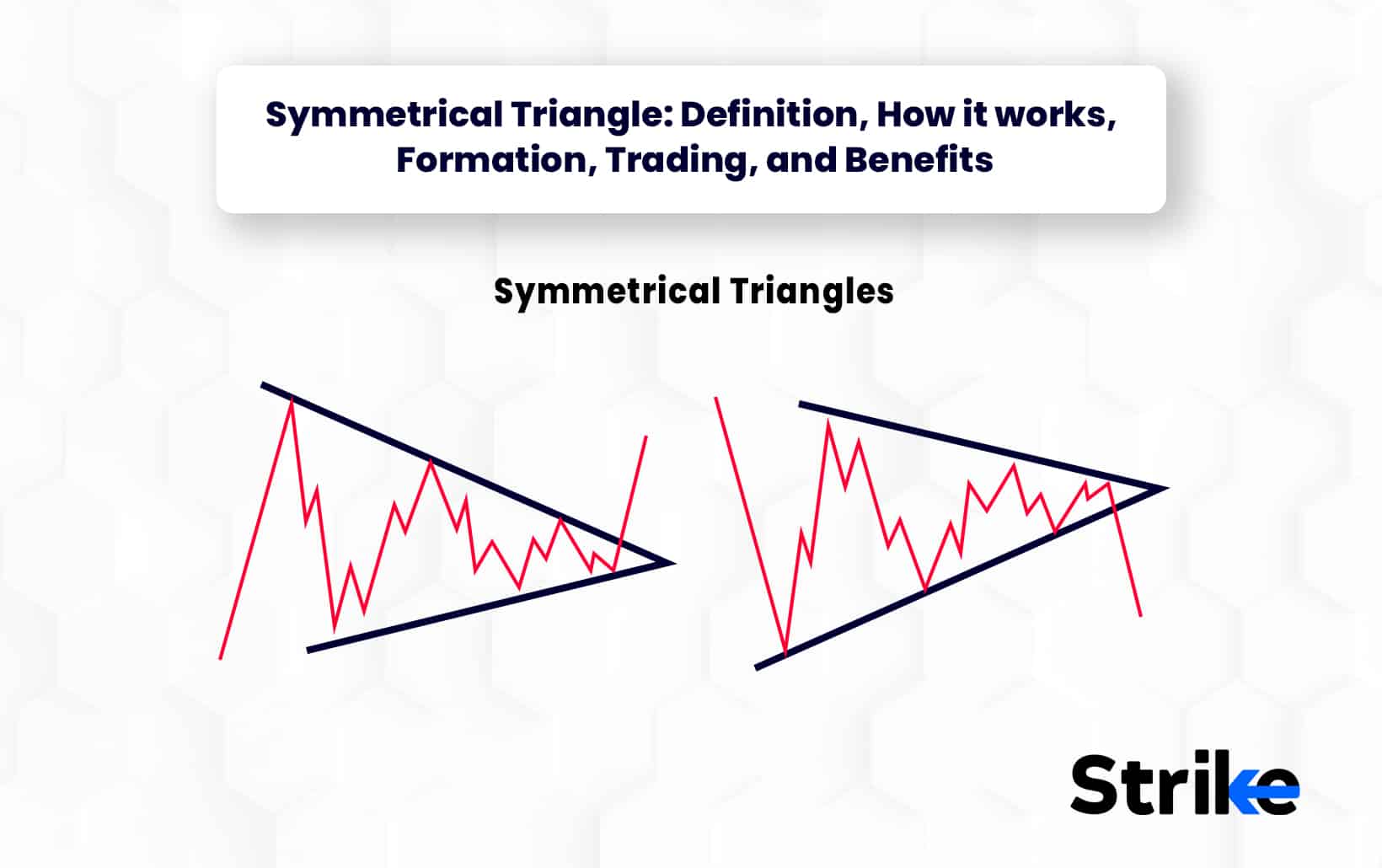





 Previous Article
Previous Article






No Comments Yet